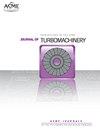Study on Additive Effect of Film Cooling Effectiveness in Two Rows of Fan-Shaped Holes
IF 3.1
3区 工程技术
Q3 ENGINEERING, MECHANICAL
引用次数: 0
Abstract
Abstract The coolant jet interaction has a great influence on the superposition prediction of multirow film cooling. Although there have been many efforts to reveal the mechanics of additive effect in multirow film cooling, the available knowledge about developing the superposition method is still limited. The present work examines the film cooling effectiveness in two rows of fan-shaped holes by pressure sensitive paint technique, at the blowing ratios of 0.5 to 2.0 and the density ratio of 1.0. It is found that the impact of upstream flow on the downstream cooling film is reflected in the variation of turbulence intensity. The enhanced turbulence intensity is detrimental to the downstream film cooling effectiveness especially at the far away region. The mixing of upstream flow and coolant ejection starts at the leading edge of the hole exit. Thus, the streamwise width of the hole exit should be taken into consideration for better predicting the film cooling effectiveness around the holes. The cause of additive effect is that the coolant ejection at the second row affects the local mainstream entrainment. Then, a new correction factor, which characterizes the influence of coolant ejection on the mainstream entrainment of the upper row, is proposed for improving the classical Sellers method. The final result shows a good agreement with experimental data.两排扇形孔气膜冷却效果的加性效应研究
摘要冷却剂射流相互作用对多排气膜冷却的叠加预测有很大影响。虽然已经有许多努力揭示多排膜冷却中加性效应的机制,但关于开发叠加方法的可用知识仍然有限。本研究在吹气比为0.5 ~ 2.0、密度比为1.0的条件下,采用压敏涂料技术研究了两排扇形孔中的膜冷却效果。研究发现上游流动对下游冷却膜的影响主要体现在湍流强度的变化上。湍流强度的增强不利于下游的气膜冷却效果,特别是在较远的区域。上游流动和冷却剂喷射的混合从孔出口的前缘开始。因此,为了更好地预测孔周围的气膜冷却效果,应考虑孔出口的流向宽度。造成加性效应的原因是第二排的冷却剂喷射影响了局部主流夹带。在此基础上,提出了一种新的修正因子,用于表征冷却剂喷射对上排主流夹带的影响,以改进经典的Sellers方法。计算结果与实验数据吻合较好。
本文章由计算机程序翻译,如有差异,请以英文原文为准。
求助全文
约1分钟内获得全文
求助全文
来源期刊
CiteScore
4.70
自引率
11.80%
发文量
168
审稿时长
9 months
期刊介绍:
The Journal of Turbomachinery publishes archival-quality, peer-reviewed technical papers that advance the state-of-the-art of turbomachinery technology related to gas turbine engines. The broad scope of the subject matter includes the fluid dynamics, heat transfer, and aeromechanics technology associated with the design, analysis, modeling, testing, and performance of turbomachinery. Emphasis is placed on gas-path technologies associated with axial compressors, centrifugal compressors, and turbines.
Topics: Aerodynamic design, analysis, and test of compressor and turbine blading; Compressor stall, surge, and operability issues; Heat transfer phenomena and film cooling design, analysis, and testing in turbines; Aeromechanical instabilities; Computational fluid dynamics (CFD) applied to turbomachinery, boundary layer development, measurement techniques, and cavity and leaking flows.

 求助内容:
求助内容: 应助结果提醒方式:
应助结果提醒方式:


